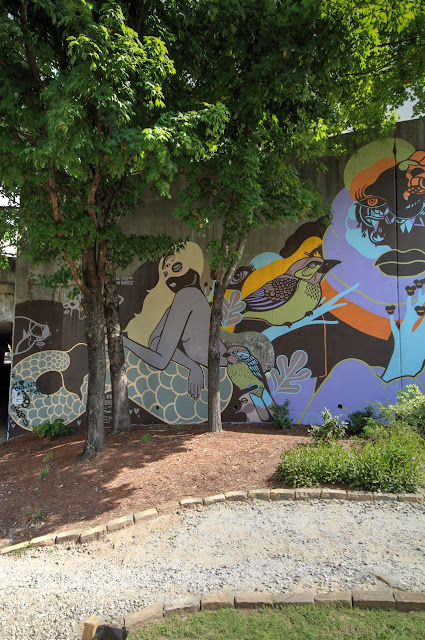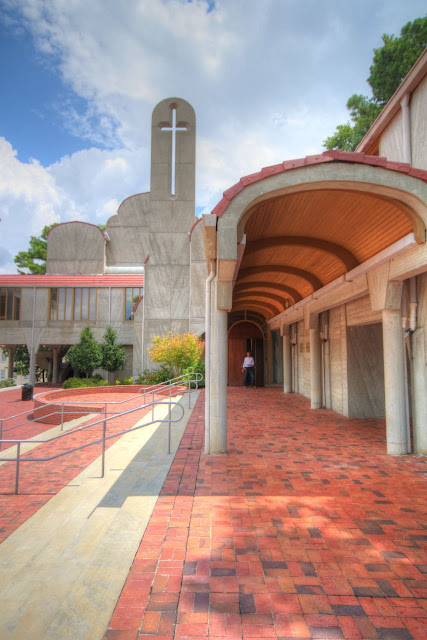Every year the bride's company has a retreat somewhere in the eastern U.S. (it has to be a day's driving from Charlotte), so I go as a supportive spouse. Last year it was Wilmington; a couple years before that it was Charleston. I almost didn't go this year, because, well: Atlanta. It's hot--and who goes to Atlanta for vacation? Yes, it was hot, but Atlanta was a worthwhile visit. It has an active mural/graffiti scene and several locales of architectural interest (as well as some yummy food and interesting history).
Below, in greater detail, is an introduction to Atlanta's greatest architect, John Portman (thanks to a post by W. Daniel Anderson); a sprinkled tour of Living Walls Atlanta; a library (and last work) by one of the original Modernists Marcel Breuer; a brief visit to MLK's neighborhood; a church by the brilliant Brutalist Paul Rudolph; an art museum by ever-lovely Richard Meier; an annex to that museum by Renzo Piano; and various randomness along the way. I walked over 30 miles of the city to collect these photos. My feet hurt!
john portman
I have to confess I had never heard of John Portman before coming to Atlanta. And if I hadn't seen photos of his interiors, I would have walked by his buildings without a second thought: they are, outwardly, big B boring. But like a creative introvert, these buildings are gaspingly gorgeous on the inside. Stunning even.
Portman did several unique things as an architect. One: he was his own client. In order to have creative control, he was the developer as well as the architect. Two: He placed his structures in neglected downtowns, taking advantage of a good location and cheap property; in the process, he turned around the downtowns of Atlanta, Times Square in New York, and Detroit. Three: Because of where he placed his projects, he created inwardly focused facilities that could meet all the needs of guests without leaving the property (his projects are presently criticized for the lack of a street presence, but that's taking his work out of its original context). Four: Because of this inward focus, he focused his architecture on the enormous interior atriums of his hotels (depending on the source, he was either the first to build hotels like this or was the one to popularize them).
Being a local boy, most of his work is in Atlanta in a part of downtown called Peachtree Center where, in addition to (at least) three massive hotels, he's built a number of office buildings, many of them Brutalist.
So here's the hotel that started it all, the Hyatt Regency Atlanta (1967). Nothing special, right? Now let's walk inside...
Holy crap! That's 22-stories of height with a translucent roof and functional abstraction. Simply stunning. Portman was influenced by Frank Lloyd Wright, and you can see that expressed in the design.
Very Wrightian...
All those plants (real!) are very Wrightian.
Here it is at night:
At the top of the elevator stalk is a UFO-looking restaurant that--wait for it--rotates. Here's a view of the hotel from a neighboring building:
The restaurant uses honey from hives atop a building next door:
Immediately to the east is Portman's Marriott Marquis (1985). In true Portman style, you can access the Marriott via a bridge. This hotel, similar to the Hyatt, doesn't appear to be anything special from the outside, although the flaring at the base suggests something is going on...
And then you go inside:
When Portman first built the Hyatt, it was one the tallest buildings in downtown; the rotating restaurant afforded a view of all of downtown. However, with the success of his redevelopment, the Hyatt was soon dwarfed by all the new construction. So Portman built the Westin Peachtree in 1976 with a triple-decked restaurant at the top, two decks of which, one for the bar and one for the restaurant, rotated. Unlike the Hyatt and the Marriott, the Westin doesn't sport a top-to-toe atrium, but it does showcase a Brutalist-Futurist atrium of some note. The view from the top? Stunning.
Around and about the hotels are various Brutalist (in some cases, Gothic Brutalist) buildings that Portman designed:
All the buidings you see here are Portmans.
Breuer's main claim to fame is being the first dude to make an all-tubular steel chair, the iconic (and still available [we have one!]) Wassily Chair. He was also Walter Gropius's right-hand man at the Bauhaus and the Harvard Graduate School of Design until he spun off on his own, often designing Brutalist structures. Atlanta hosts Breuer's last realized design, the Atlanta Central Library (1980). Reminiscent of New York City's former Whitney Museum of Art (1966), the library has risked meeting the wrecking ball but seems to be in good hands at present (the original concept for the library dates to 1969; it took a decade to get funding). Outside, the building is rather gorgeous with abstract cubist cantilevers and rough and smooth surface-defining volumes. Inside, the library is rather blah and utilitarian except for the central stairwell (unclear if the interior had been modified or not). We sweet-talked our way to the outdoor patio (I was with a friend, and since we both wear mildly fashionable eyeglasses, they thought we were architects).
A tornado came through and damaged one of the skylights. The repairs were not adequate to keep it from leaking (the other three originals have never leaked).
Breuer bedecked the library with his chairs, one of which was on display (the rest are in storage).
Also on display were various artifacts of Margaret Mitchell's, author of "Gone with the Wind" and an Atlanta native.
The wall hanging is a Breuer.
misc.
There's a SOM (aka a Poor Man's Mies van der Rohe) building downtown.
Flintstone Brutalism?
Interesting way to achieve greater auto density.
mlk
Martin Luther King hailed from Atlanta. His church, homestead, and burial site are near downtown at the Martin Luther King Jr. National Historic Site.
graffiti and misc
Lots of murals and graffiti near the MLK national historic site.
more graffiti and misc
Back downtown there are more murals and whatnots.
Googie burger!!!
Neoplastic playscape.
Some Post-Modernism at Steve Polk Plaza near the state capitol; the previous home of the World of Coca-Cola.
An architectural "duck" (a term coined by Post-Modernist Robert Venturi) at the College Football Hall of Fame (2014, tvs-design)
Atlanta is also the birthplace of Coca-Cola and hosts the World of Coca-Cola (2005; Rosser International)
A peek at the National Center for Civil and Human Rights (2014; Phil Freelon and HOK [HOK developed the ill-fated concept for the Austin Planetarium])
The tragic fire that led to fire safety rules for skyscrapers.
Gorgeous Brutalism of the SunTrust Bank Building.
krog street tunnel
The Krog Street Tunnel is the place to go and check out murals and graffiti. Ironically, the best part of the "tunnel" is outside of the tunnel along Wylie Street.
A nearby house...
On the western side of the Wylie Street murals is a neat re-use project that turned a cotton processing plant into apartments.
Paul Rudolph has designed some legendary if not controversial Brutalist structures, most famously at Yale. The Cannon Chapel at Emory University (1975-1981) is a nice example of his work, what I might call, in this case, soft Brutalism.
richard meier
Since we love-love-love Richard Meier, we were excited to experience one of his earlier works, the High Museum of Art (1983). A year later, he won the Pritzker Prize for architecture. Meier channels Corbusier and other early Modernists circa the idealistic 1930s but for today's world, and it demonstrates the continued relevance of Modern's message to architecture.
The museum has one of Gerrit Rietveld's de Stijl chairs!
Some stuff by Frank Lloyd Wright
Our de Stijl buddy Piet Mondrian.
Rocking chair by the Austrian company Gebruder Thonet.
That's a freaking cool stereo.
A chair by the proto-Modernist Josef Hoffman.
A cool as eff desk lamp by Donald Deskey (valued at $250,000 to $350,000).
Frank Lloyd Wright furniture from the Johnson Wax Headquarters.
Eames furniture.
renzo piano
Renzo Piano, he of the sympathetic addition to Louis Khan's Kimbell Art Museum in Fort Worth, has also brought his sympathetic touch to an addition to Meier's work in Atlanta.
Meier to the right; Piano to the left.
a few parting shots...
And there you have it: Atlanta! There was more to see, of course, but we seen a lot.
If you go:
- Top 50 architectural sites in Atlanta
- Where to see graffiti in Atlanta
- Living Walls Atlanta
SaveSaveSaveSave






































































































































































































No comments:
Post a Comment